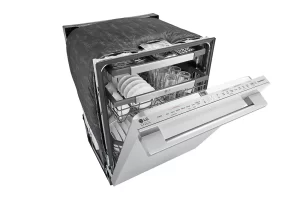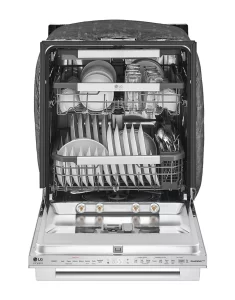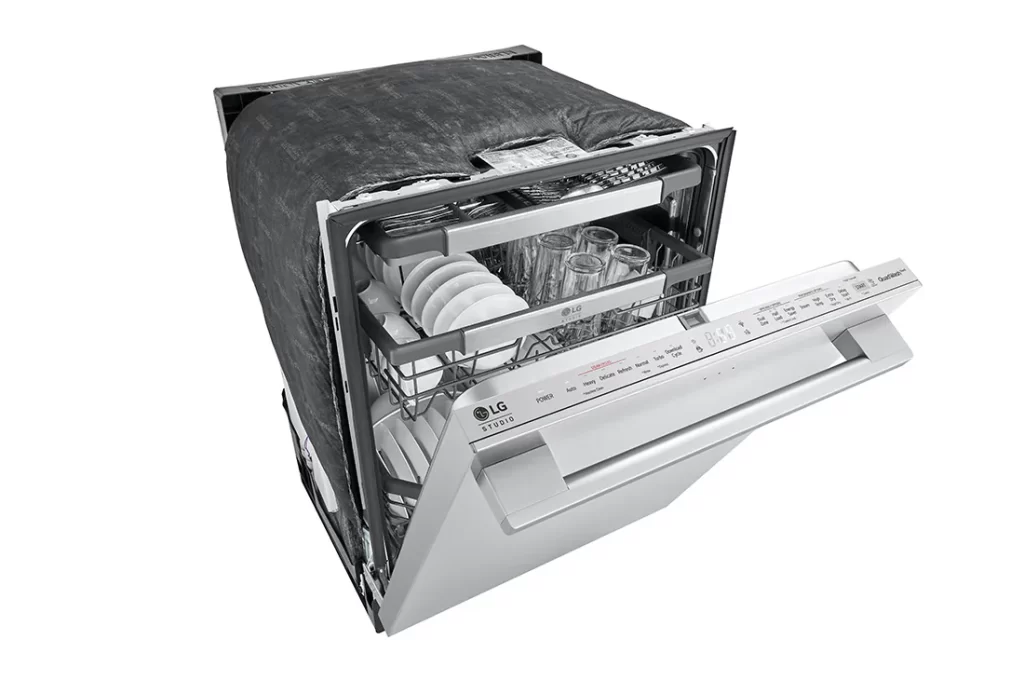Maintaining a mold-free dishwasher is crucial not only for the appliance’s longevity but also for your health and the cleanliness of your dishes. Mold growth inside the dishwasher can lead to unpleasant odors, poor cleaning performance, and potential health hazards. In this guide, we’ll provide you with a straightforward and effective approach to removing mold from your dishwasher while also sharing preventive measures to ensure it stays mold-free in the future.
Recognizing Signs of Mold Growth

Identifying Mold in your dishwasher is the first step in effectively addressing the issue. Mold often starts as subtle signs, but with vigilance, you can catch it early.
Signs of Mold Growth:
One of the most apparent signs is the presence of black, green, or grayish patches on the dishwasher’s interior. These patches may appear as spots or cover larger areas. They are a clear indicator of mold infestation.
Another common sign is a musty and unpleasant odor. If your dishwasher emits a foul smell, even after a cycle, it could be due to mold growth. This smell often transfers to your dishes, leaving them with an undesirable odor.
Additionally, keep an eye out for any residue or discoloration on your dishes. Mold can sometimes transfer to your plates and glasses, leaving behind noticeable marks or an unusual taste.
Common Areas for Mold Buildup:
Mold tends to thrive in damp and dark environments, making your dishwasher an ideal breeding ground. Pay close attention to these common areas:
- Rubber Seals and Gaskets: The door seals and gaskets are prime spots for mold to hide. Their crevices often collect moisture, creating a perfect environment for mold growth.
- Spray Arms: Mold can accumulate on the dishwasher’s spray arms, affecting their functionality and spreading mold to your dishes during cycles.
- Filter and Drain: The dishwasher filter and drain can become clogged with food particles and debris, creating a moisture-rich environment where mold can thrive.
- Interior Walls and Racks: The interior walls and racks, especially corners and crevices, may harbor hidden mold. Regular inspection is essential to catch any early signs.
In summary, identifying mold in your dishwasher involves being vigilant about visual cues like discoloration, unpleasant odors, or residue on dishes. Regularly checking common mold-prone areas such as rubber seals, spray arms, filters, and interior surfaces will help you catch and address mold growth promptly.
Best Bootle Dishwasher: impressive guid
Ensuring Your Safety During Mold Removal
When it comes to tackling mold in your dishwasher, safety should be a top priority. Taking the right precautions not only protects your health but also ensures an effective and risk-free cleanup.
Necessary Protective Gear:
Before you begin, gather the following protective gear:
- Gloves: Wear disposable or rubber gloves to shield your hands from direct contact with mold and cleaning chemicals. Ensure they fit snugly to prevent any seepage.
- Safety Goggles: Mold spores can become airborne during the removal process, potentially irritating your eyes. Safety goggles offer essential eye protection.
- Respirator Mask: Invest in an N95 or higher-rated respirator mask to filter out mold spores and prevent inhalation. A regular dust mask won’t provide adequate protection.
- Long-Sleeved Clothing: Opt for long sleeves and pants to minimize skin exposure to mold.
- Closed-Toe Shoes: Wear closed-toe shoes with socks to protect your feet.
Ventilation and Ventilation Equipment:
Proper ventilation is essential to prevent inhaling mold spores and to expedite the drying process. Here’s what you need to do:
- Open Windows and Doors: Begin by opening windows and doors to create cross-ventilation. This helps disperse airborne mold spores and introduces fresh air.
- Use Fans: Position fans in the room to increase airflow. This aids in reducing humidity levels and expedites the drying process. Box fans or exhaust fans can be particularly effective.
- Dehumidifier: If available, use a dehumidifier in the area to lower humidity levels, making it less conducive for mold growth.
- Seal Off the Area: If possible, seal off the room or area where you’re working with plastic sheeting and tape to prevent the spread of mold spores to other parts of your home.
By adhering to these safety precautions, you’ll create a protective barrier between yourself and the mold, reducing health risks. Proper ventilation ensures that mold spores are swiftly removed from the environment, making the removal process safer and more effective.
Essential Supplies and Tools for Effective Mold Removal

To effectively tackle mold in your dishwasher, it’s essential to have the right supplies and tools at your disposal. Here’s a comprehensive list to ensure you’re well-prepared:
List of Required Cleaning Supplies:
- White Vinegar: A natural and effective mold remover, white vinegar helps break down mold and eliminate odors. You’ll need a sizeable quantity.
- Baking Soda: This versatile powder not only helps remove mold but also acts as a mild abrasive for scrubbing.
- Hydrogen Peroxide: A powerful disinfectant, hydrogen peroxide is excellent for killing mold and bacteria.
- Dish Soap: A mild dish soap is useful for general cleaning and washing affected dishes.
- Cleaning Cloths or Sponges: Have a stack of clean, disposable cloths or sponges on hand for wiping down surfaces and scrubbing.
- Toothbrush or Small Brush: These are handy for getting into tight spots and crevices where mold may hide.
- Bucket: Use a bucket to mix cleaning solutions and carry water for rinsing.
- Plastic Scraper: For gently scraping off stubborn mold without damaging surfaces.
Tools for Effective Mold Removal:
- Rubber Gloves: Ensure you have sturdy rubber gloves that provide adequate protection for your hands.
- Safety Goggles: Protect your eyes from splashes and airborne mold spores.
- Respirator Mask: A high-quality respirator mask is crucial to prevent inhaling mold spores during removal.
- Screwdriver: Depending on your dishwasher model, you may need to remove certain components for thorough cleaning.
- Flashlight: A flashlight can help you spot hidden mold in dark corners.
- Microfiber Cloth: Ideal for drying and buffing surfaces to a shine after cleaning.
- Plastic Sheeting and Tape: If needed, use these to seal off the work area and prevent mold spores from spreading.
Having these supplies and tools readily available will make your mold removal process more efficient and safer. Remember to double-check that you have everything on the list before you start, as being well-prepared is key to a successful cleanup.
how to unclog a dishwasher with standing water
Efficient Steps to Remove Mold from Your Dishwasher
Removing mold from your dishwasher may seem daunting, but with the right approach, it can be a straightforward process. Here’s a detailed step-by-step guide to ensure your dishwasher is mold-free and ready to use.
Preparing the Dishwasher:
- Start by unplugging the dishwasher from the power source or turning off its circuit breaker to ensure safety during the cleaning process.
- Remove all dishes, utensils, and dishwasher racks, setting them aside for later cleaning.
- If your dishwasher has a filter, take it out and rinse it thoroughly. Dispose of any food debris collected in the filter.
Removing and Cleaning Dishwasher Components:
- For effective mold removal, you may need to disassemble certain components, such as spray arms, baskets, and racks. Check your dishwasher’s manual for guidance on removal and reinstallation.
- Submerge these components in a mixture of equal parts white vinegar and water. Let them soak for about 30 minutes to loosen mold and grime.
- After soaking, scrub the components with a soft brush or toothbrush to remove any remaining mold and residue. Rinse them thoroughly with clean water.
Cleaning the Interior:
- Wipe down the dishwasher’s interior, including the walls and door, with a cloth soaked in a solution of white vinegar and water. Ensure you reach all corners and crevices.
- Use a toothbrush or small brush to clean hard-to-reach areas, like rubber seals and gaskets, where mold often lurks.
Dealing with Stubborn Mold:
- If you encounter stubborn mold that won’t come off easily, create a paste using baking soda and water. Apply this paste to the affected areas and let it sit for 10-15 minutes before scrubbing.
- For persistent mold, a mixture of hydrogen peroxide and water (1:1) can be effective. Apply it, let it sit for 10 minutes, and then scrub.
Final Inspection:
- Reassemble the dishwasher components you removed earlier, ensuring they are properly placed.
- Run the dishwasher on an empty cycle with a cup of white vinegar placed in the top rack. This will help eliminate any remaining mold and sanitize the dishwasher.
- Once the cycle is complete, open the dishwasher door and let it air dry completely.
By following these steps, you’ll have successfully removed mold from your dishwasher and taken the necessary measures to prevent its return. Your dishwasher will be clean, odor-free, and ready to use, ensuring your dishes come out sparkling clean and free of mold.
Proactive Strategies to Keep Mold Out of Your Dishwasher
Now that you’ve successfully removed mold from your dishwasher, it’s essential to implement preventive measures to ensure it remains mold-free in the future. Here are practical steps you can take to maintain a healthy dishwasher environment.
Tips for Regular Maintenance:
- Routine Cleaning: Make dishwasher cleaning a monthly habit. Empty the dishwasher, remove any debris from the filter, and wipe down the interior with a vinegar and water solution.
- Keep It Dry: After each wash cycle, leave the dishwasher door slightly ajar to allow moisture to evaporate. This prevents mold-friendly, damp conditions from forming.
- Scrape Dishes: Before loading dishes, scrape off excess food to prevent food particles from accumulating in the dishwasher.
- Use Dishwasher Cleaner: Periodically use a commercial dishwasher cleaner to remove mineral buildup and keep the dishwasher’s interior clean.
Strategies to Keep Mold at Bay:
- Use Hot Water: Opt for the “heated dry” option if your dishwasher has one. Hot water helps to kill mold spores and prevents their growth.
- Proper Loading: Avoid overcrowding the dishwasher, as it can block water and detergent from reaching all surfaces, increasing the risk of mold growth.
- Check Seals and Gaskets: Regularly inspect the rubber seals and gaskets for signs of mold or deterioration. Replace them if necessary to maintain an airtight seal.
- Ventilation: Ensure the area around the dishwasher has good ventilation. This reduces humidity levels, making it less conducive for mold growth.
- Use Powdered Detergent: Consider switching to powdered dishwasher detergent rather than liquid, as it tends to leave fewer residues.
- Regular Filter Cleaning: Clean the dishwasher’s filter as needed, ideally once a month, to prevent clogs that can trap moisture and encourage mold growth.
By incorporating these tips and strategies into your dishwasher maintenance routine, you can significantly reduce the chances of mold returning. Consistency is considered the key to maintain a mold-free dishwasher, ensuring that your dishes remain clean and safe for everyday use.
Taking Control of Your Dishwasher’s Mold-Free Future
In conclusion, you’ve now equipped yourself with the knowledge and strategies to effectively remove mold from your dishwasher and maintain a mold-free environment. Let’s recap the essential points and emphasize the significance of regular maintenance for a mold-free dishwasher.
Recap of Efficient Dishwasher Mold Removal Tips:
We began by understanding the signs of mold growth, which include visible patches, unpleasant odors, and residue on dishes. Common areas for mold buildup were identified, highlighting the importance of thorough inspection.
Safety precautions were emphasized, urging you to wear protective gear like gloves, safety goggles, and a respirator mask. Proper ventilation through open windows, fans, and dehumidifiers was stressed to create a safe and effective work environment.
To carry out the mold removal process, a comprehensive list of cleaning supplies and tools was provided, including vinegar, baking soda, hydrogen peroxide, brushes, and safety equipment. This ensured that you were well-prepared for the task at hand.
The step-by-step mold removal process guided you through preparing the dishwasher, removing and cleaning its components, tackling stubborn mold, and conducting a final inspection. These steps, when followed diligently, resulted in a mold-free dishwasher ready for use.
Importance of Regular Maintenance for a Mold-Free Dishwasher:
However, our journey doesn’t end here. The conclusion underscores the necessity of ongoing dishwasher maintenance to prevent mold from reappearing. Monthly routine cleaning, proper drying, and the use of hot water were recommended as key practices to maintain a mold-free environment.
Tips for regular maintenance, such as scraping dishes before loading, using dishwasher cleaner, and inspecting seals and gaskets, were highlighted to ensure that mold does not find a foothold in your dishwasher.
Strategies to keep mold at bay, such as loading dishes properly, maintaining good ventilation, and using powdered detergent, were outlined as proactive measures to prevent mold growth.
By following these tips and strategies consistently, you can take control of your dishwasher’s mold-free future. This not only ensures clean and safe dishes but also contributes to a healthier living environment for you and your family. With regular maintenance, your dishwasher will continue to serve you well, free from the hassles of mold-related issues.

